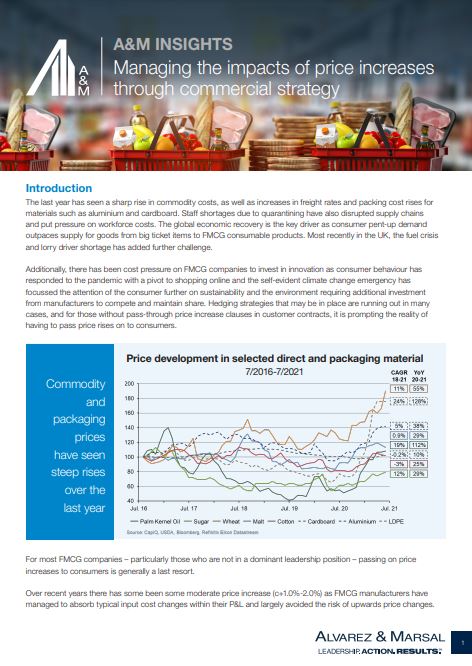The last year has seen a sharp rise in commodity costs, as well as increases in freight rates and packing cost rises for materials such as aluminium and cardboard. Staff shortages due to quarantining have also disrupted supply chains and put pressure on workforce costs. The global economic recovery is the key driver as consumer pent-up demand outpaces supply for goods from big ticket items to FMCG consumable products. Most recently in the U.K., the fuel crisis and lorry driver shortage has added further challenge.
Additionally, there has been cost pressure on FMCG companies to invest in innovation as consumer behaviour has responded to the pandemic with a pivot to shopping online and the self-evident climate change emergency has focused the attention of the consumer further on sustainability and the environment requiring additional investment from manufacturers to compete and maintain share. Hedging strategies that may be in place are running out in many cases, and for those without pass-through price increase clauses in customer contracts, it is prompting the reality of having to pass price rises on to consumers.
Current pricing activity in market, the consumer awareness of cost pressures and the publicity around price across sectors offers the opportunity to take decisive action. Consumer Goods companies can benefit from applying a structured, rapid and comprehensive approach, and for this A&M advises six clear steps.

Optimizing Indirect Functions: The Hidden Key to Manufacturing Efficiency
June 17, 2025
Unlock the hidden potential of manufacturing efficiency by diving into the often-overlooked world of indirect functions. From logistics and quality assurance to maintenance and planning, these areas hold the key to agility, cost reduction, and operational excellence.
A&M Activist Alert
June 16, 2025
The 2020s have seen periods of heightened market turmoil not seen since 2011 and 2008. The impacts of the Covid-19 pandemic, the war on Ukraine and now additional geopolitical events including trade and tariff wars, have presented significant challenges for corporates.
Managing Director Daniel Schmeltz Featured in Chief Executive
June 9, 2025
Managing Director Daniel Schmeltz featured in Chief Executive's article "Ditch Your Growth Obsession And Focus On Profit".
Board Composition: A Strategic Asset or Challenging Weakness
April 23, 2025
A&M Managing Directors Conor Johnston, Paul Kinrade, Annie Peabody and Andy Walker explore what sets high-performing boards apart, backed by a study of more than 3,300 companies. They dive into how factors like director tenure, board refreshment, CEO and chair separation and the right mix of technical and regional expertise all play a role in boosting long-term results.




